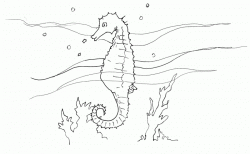Strike zone: Seahorse's neck helps it snag prey
Q. Why does a seahorse look so bizarre? –J. Cousteau
A. Given its equine head, pot belly, and prehensile tail, it's easy to forget that the seahorse is a fish, says New Scientist magazine. Importantly, its arched neck acts like a spring for storing energy, ensuring that the seahorse is ready to strike when it spots a meal.
To study this, biologist Sam Van Wassenbergh at the University of Antwerp, Belgium, used mathematical models of the seahorse's body shape, comparing them to models of pipefish, its straight-bodied cousin. The necks of seahorses were shown to have the elasticity and stability needed to let them lunge and grab a passing shrimp, even from some distance away; pipefish, by contrast, are limited to much closer prey.
"Seahorses enjoy a 20 percent increase in their strike zone thanks to the shape of their head and neck.” Because they are weak swimmers, "every extra millimetre they can reach becomes important since it means more food," says Van Wassenbergh.
Q. What are some mind-boggling numbers your body can boast about? For instance, how many heartbeats have you been allotted over the years? –A. Taylor
A. Roughly 2.5 billion by the time you reach 70 years old, answers ScienceIllustrated.Com magazine. Some of the fastest neurons in your spinal cord can send signals at nearly 300 mph, or half the speed of sound. About 40 percent of all the atoms in your body, such as oxygen and carbon, originated in supernova explosions. The remaining 60 percent are hydrogen atoms formed during the Big Bang.
Your sense of smell is probably sensitive enough to detect 10,000 different scents. Each of your retinas contains over 100,000,000 photoreceptors. The interior surface of your lungs, if unfolded, would cover nearly 100 square yards, or about a third of a tennis court.
Finally, consider your brain: It makes up only 2 percent of your body's weight but receives 15-20 percent of the blood supply. By the 10th week of development, your fetal brain was creating 250,000 neurons every minute, until reaching about 100,000,000,000 (100 billion), linked by 100,000,000,000,000 (100 trillion) synapses, or connections. That, says Valerie Ross in Discover magazine, "is at least 1,000 times the number of stars in our galaxy."
Q. See if you can form nine consecutive words by adding or inserting only a single letter to each previous word, starting with a common single-letter word. –N. Webster
A. I, in, sin, sing, sting, string, staring, starting, (or starling) and startling (from the Central Washington University's Writing Center).
Q. Imagine newborn identical twins Adam and Andrew receiving the best medical, dietary, and social upbringing of their day, and yet adult Adam turns out to be about three inches taller than adult Andrew and scores roughly 20 points higher on the same intelligence test. What's the trick here? –M.K.Olsen
A. And quite a trick it would be to send Adam forward via time machine to be similarly raised by a family of 2050, since the extra three inches is about what males gained on average from mid-20th century to the turn of this century, as determined from data both in the U.S. and Britain, report researchers W. H. Angoff and R. Lynn.
Since height is largely genetic, subtle non-genetic (environmental) factors must be at play to help account for three-inch difference. Harvard geneticist Richard Lewontin once called this the "fertile field effect," referring to how one field of corn plants well nurtured could wind up on average taller than an identical field not so well nurtured.
For similar reasons (not well understood), Adam would wind up with an IQ score maybe 20 points higher than his twin brother, since IQ scores go up roughly 6 points each generation, called the Flynn effect. The effect is generally masked because scores are periodically re-normed.
~
Send Strange questions to brothers Bill and Rich at [email protected]
